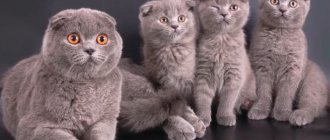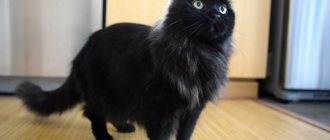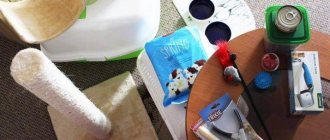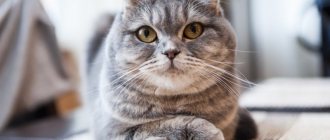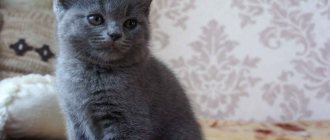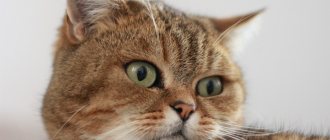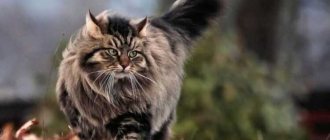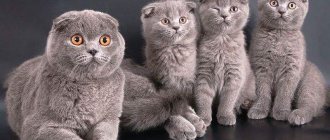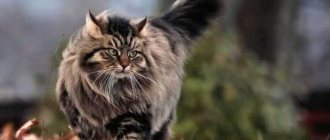History of the origin of the Scottish Fold breed
The history of the origin of the Scottish Fold is quite unusual, because the breed was bred from a yard cat with long hair and unusually curved ears; at that time, this ear structure was considered a genetic mutation. In 1961, in Scotland, a shepherd interested in breeding cats noticed a white long-haired yard cat with an unusual ear shape. When the cat gave birth to kittens, he took one cat for himself, raised it and mated it with a British shorthair cat. As a result of this crossing, straight-eared and lop-eared kittens appeared.
Initially, the breed was simply called Fold; it received the Scottish prefix a little later in the place where it was bred. There are two types of the breed - short-haired and long-haired fold cats.
The breed was bred by a Scottish shepherd and got its name from the place where it was bred.
As a result of experiments with breeding Scottish fold cats, it was revealed that the mutation gene is dominant, which means that if one of the parents has the gene for folded ears, then kittens can appear with the same ears.
After some time, people in Scotland stopped breeding this breed out of fear that the mutation could have consequences in the form of ear infections or deafness in cats, which is why the breed was never officially recognized in Scotland. Active breeding of the breed began only in 1978 in the USA. In the same year, the breed was officially registered in one of the largest felinological organizations called CFA (Cat Fanciers' Association). The breed was never recognized by the International Federation of European Cat Breeding (FIFE) due to lop ears and associated mutations. But regardless of this, Scottish Folds are very popular in America and Australia.
Today, the Scots rank fourth in popularity among cat breeds, sharing it with the British Shorthair. The exotic cat, Persian and Maine Coon are ahead of them.
Character of Scottish folds
Scottish Folds have a unique character, so they are considered true phlegmatic people with diluted melancholy. They are so cautious and selective towards people, including family members, that it can border on pathology. They are always on guard and listen to something, fearing some surprises from the outside, while they recognize one of all family members as the owner. The cat will always come to this owner when it feels too lonely. It will allow him to stroke his tummy while sitting comfortably on his back.
The Scottish Fold's second favorite pose is the Buddha pose. Scottish Folds quite often stand on their hind legs when they notice something interesting or when begging their owner for something tasty.
The Scottish Fold, like the British Shorthair, does not show much activity and behaves very reservedly, which many perceive as a sign of innate intelligence.
As a rule, this breed will never bother its owner without a serious reason. They voice solely out of despair when there is no food or water in the bowl. At the same time, the voice of these animals is not as soft and beautiful as their appearance. Most likely, you will have to hear a very unpleasant Scottish “meow”.
The Scottish Fold always coexists without conflict with other pets due to its calm disposition. They are able to calmly watch as a completely unfamiliar cat or tom eats food from a bowl. Most likely, they think that it is not worth getting into a fight over this nonsense.
The fold-eared cat reacts very peculiarly to strangers. She does not show any interest and, most likely, disappears from sight, without giving any chance for reciprocal expressions of feelings of joy and delight. Another interesting feature of the breed is its disregard for its owner’s knees. These animals begin to show feline tenderness either in old age or after castration.
Scottish Folds also do not imagine themselves in the company of children, since they do not like to be cuddled and can hardly tolerate raised tones.
Many representatives of this breed are so fearful that they often experience panic attacks. If you take a cat with you to the dacha, he will find shelter there and sit there all the time without getting out: the change of situation has such a shocking effect on him.
It is important to know! Despite such nuances in the behavior of Scottish Folds, they are so attached to their owner that they get bored when he is not around for a long time.
Scottish Fold - All about the cat breed
Description of the fold breed
Scottish Folds are usually medium in size. The height at the withers of an adult is from 20 to 30 cm. The body is elongated, flexible, the tail is medium or long, depending on the proportions of the cat’s body. Weight is only 1.5–2 kg. The breed's ears look like a folded envelope, but there are three types:
- ears pressed firmly to the head;
Ears that are pressed tightly against the head require frequent care.
- less flattened ears;
- folded just half of the auricle.
The head is perfectly round. The eyes are large, the color most often depends on the coat color and varies from blue to amber-brown. The coat is soft, plush, and short.
The colors of the Scots are very different: blue, lilac, black, white, two-color, for example, Whiskas color - gray and white stripes all over the body or red and white, multi-colored (tortoiseshell - a combination of white, red and black).
Photo gallery: Scottish Fold cat colors
The monochromatic chocolate color of the fold cat does not allow undercoat of a different shade
Tortoiseshell colors are found in cats; for cats, this color is a genetic failure
The name of the popular "Whiskas" color - gray and white stripes - comes from a food advertisement
Most often, the color of a cat's eyes depends on the shade of its fur.
Newborn white kittens are allowed to have spots on their fur, but adults must be perfectly white
The long-haired Scottish cat is similar to the short-haired cat: medium-sized body, long tail, ears pressed to the head, huge eyes. The weight of an adult cat is from 3 to 8 kg. The cat is distinguished by its long, beautiful hair, which makes it look like a big fluffy ball.
The Highland Fold has long and beautiful hair, which is why it looks like a big fluffy ball.
How to choose a kitten
Fold kittens are not rare; they are easy to buy in Russia. The prevalence of the breed is great; breeders can be found in every city, and nurseries can be found in big cities. The cost of kittens starts from 1.5 thousand rubles. The main thing is to know why the cat is being purchased.
If you do not plan to take your cat to shows or win medals, pay attention to the health, activity and appearance of the animal. Take the time to check the pedigree and make sure that you are buying a kitten of the right breed, and also get a health and vaccination certificate from the seller.
If the cat is needed for shows and exhibitions, you should study the proposed pet more carefully.
Buy a cat at the age of 3 months, this way all the external signs of the breed necessary for exhibitions will be better visible. The cat must be vaccinated, litter trained, have beautiful smooth fur, clean eyes, nose and ears. The shape of the ears of the Scottish Fold is usually distinguished by creases towards the forehead, but in small individuals the ears remain raised. They lower when the cat's head gets larger.
Pay attention to the tail: ideally it will be without kinks, straight and even. The cat's paws should also be free of knots, and the joints should be mobile and not enlarged.
Character and behavior
Most often, most representatives of the breed are good-natured cats. But there are always exceptions to the rules - some fold-eared cats may have a wayward character, be unsociable, may not pay attention to the owner’s calls and may not even come up to be petted.
But in most cases, Scots love attention and affection, get along well in the family, get along with children and other animals, especially if they grew up together.
If you brought a new pet into your home, introduce them to the cat in doses so that the animals get used to each other and do not make each other want to fight.
Fold cats can treat strangers with caution and great caution, but once they realize that they are not in danger, they will easily make contact.
A fold-eared cat senses who its owner is, and it will not leave him even one step, in some cases it can even protect him from any danger. The breed is very active, loves to play with various teasing toys or simply chase a small ball or toy mouse. They can play on their own, but prefer human attention and participation in joint games. They also like to spend their rest next to a person, curling up in a ball and sometimes looking at what the person is doing.
Fold cats love to play, especially if the owner takes part in their games.
Health and necessary vaccinations
Representatives of the Scottish Fold are considered a relatively healthy breed, but, like all artificially bred cats, there are nuances.
The external beauty of pets is not always achieved without side effects. The congestion of the ears in the Scottish Fold cat breed makes them vulnerable to bone diseases and rickets. This is a consequence of a gene mutation, which veterinarians are not yet able to combat. These diseases intensify when the cat catches a cold, so drafts and cold air are contraindicated for representatives of the breed.
Pets with floppy ears are prone to bronchitis, eye and nose diseases. Doctors call another characteristic ailment of the breed hemophilia, a blood clotting disorder.
The negative aspects are that if a lop ear develops a genetic disease, it cannot be cured. Therapeutic treatment during exacerbations will help reduce the animal’s suffering.
Vaccinations help cats stay healthy and free from infectious diseases. The first time a kitten is vaccinated is at the age of two months. The set of vaccinations is standard for all kittens. From rabies, infectious diseases, plague at intervals of a month, and then a year. Vaccinations for purebred cats are usually carried out by veterinarians, but before the procedure they are advised to carry out a course of anthelmintic procedures.
Diseases of the breed
The life expectancy of Scottish Fold cats is from 10 to 15 years. In order for your animal to live a long and healthy life, it is necessary to visit a veterinarian promptly, receive appropriate vaccinations, have joints checked, and follow the veterinarian's advice. The breed has some underlying health problems.
Hypertrophic cardiomyopathy
Hypertrophic cardiomyopathy is a hereditary heart disease. Symptoms:
- tachycardia;
- dyspnea;
- heavy breathing with wheezing;
- pulmonary edema;
- fainting;
- failure of the pelvic limb; in rare cases, both limbs may fail;
- high blood pressure.
The disease is diagnosed by measuring blood pressure at a veterinarian, undergoing echocardiography (data on the functionality of the heart is revealed), visual assessment, x-ray diagnostics, and electrocardiography. Animals in serious condition should be treated only in a hospital hospital, where there are all conditions for such cats. A veterinarian examines the animal’s condition and prescribes treatment, light physical activity and a special diet. If the animal feels better, it can be treated at home, unquestioningly following all the instructions of the treating veterinarian. The problem can be cured, but such cats will always have to be checked by veterinary cardiologists.
Degenerative joint disease
This disease is characterized by the fact that pain is present in the tail (most often) and the mobility of the limbs is reduced. Symptoms:
- obvious lameness;
- the cat’s reluctance to jump on chairs or sofas;
- it is difficult for a cat to get up from the floor after resting;
- frequent and prolonged licking of joints when washing;
- the cat becomes irritable and may hiss, scratch or bite.
The disease is treated with anti-inflammatory non-steroidal drugs; if the disease is advanced, antibiotics are prescribed. Additionally, a diet may be prescribed.
Osteochondrodysplasia
It is expressed in deformation of the paws, skeleton, and immobility of the tail. Symptoms:
- lameness (may pass and reappear, and an animal with illness will not be able to jump on high ground);
- squat appearance;
- stiff gait;
- acute reaction to touching the tail;
- severe deformation of the hind limbs;
- unsteady gait.
Treatment is aimed at eliminating symptoms with medication. In the absence of polycystic kidney disease, a non-steroidal anti-inflammatory drug can be prescribed; it will relieve the cat of pain and reduce inflammation. Additionally, vitamin complexes and special supplements are prescribed. In the UK, such sick cats undergo irradiation of their extremities; for a long time the cat can calmly walk, run and jump. In Russia there are no such technologies, so such operations are not carried out.
The disease often occurs when two fold-eared cats are crossed. From such parents there will be sick offspring with problems with the musculoskeletal system and skeletal structure.
Choosing a Scottish Fold kitten
If you want an animal for exhibitions and further breeding, then look for a kitten in elite nurseries. Most have websites on the Internet where you can see reviews, the animals themselves, information about the breeder and other useful things. If you just need a pet for the soul, then you can look for a pet on websites with advertisements.
Regardless of what purpose you need the animal for, first of all pay attention to the appearance and behavior of the kittens. Healthy kittens are active, with soft fur and non-running eyes. If the kitten is lethargic, then this is a sure sign of some kind of illness. Ask the breeder to show you the kittens' parents - you can roughly imagine what the kitten will look like in the future.
When choosing a kitten, you need to pay attention to activity: the more active the animal, the healthier it is.
Ask about the age of the kittens. The best age for selling offspring is 3 months, at this time the kittens are already quite independent: they eat, wash themselves, play and go to the toilet. Ask the breeder about documents: veterinary passport and pedigree (if available and you need).
The veterinary passport must contain notes on the animal’s vaccination, as well as notes on the treatment of the kitten for helminths.
If there are a lot of kittens, then watch them; the characteristics of their character or behavior will help you choose exactly the kitten that will suit you. When choosing a gender, think about it: if you want to mess with small kittens, then choose a cat - there are fewer problems with them, they will not mark every corner, unlike cats. If you want a cat, then be prepared for the fact that he may mark sofas, carpets or curtains. In addition, it is worth deciding whether you will spay/neuter your animal.
Prices for fold-eared kittens depend on the availability of pedigree, color and coat length. Long-haired Scottish Folds cost twice as much as short-haired ones. A kitten without a pedigree costs from 3 to 6 thousand rubles, with a pedigree - from 10 to 40 thousand rubles.
Distinctive features of this breed:
- soft plush fur;
- ears pressed to the head;
- unusual coat color;
- short hair in Scottish Folds, long hair in Highland Folds;
- small but elongated body, small tail;
- All kittens have blue eye color, the shade changes with age;
- at three months, the kitten weighs no more than 500 g, and its height at the withers is about 15 cm.
How to care for a kitten
When you bring your new pet home, make sure he has everything he needs. This includes:
- house;
- toilet;
- bowls for food and water;
- comb for cats;
- toys.
A small kitten requires increased attention to itself. In the first week he may be intimidated and unsociable, this is explained by the change of place, over time he will get used to it. At first, food, a house and a toilet should be nearby so that the animal does not get lost and make a puddle on the carpet.
The kitten should be fed in small portions, from 2 to 6 months at least five times a day. Clean, fresh, unboiled water should always be available. You can bathe the animal once every three or four months as it gets dirty, the ears should be cleaned as they get dirty, don’t forget about the eyes, from which tears can flow, they can be wiped with a cotton pad.
Scottish Fold ears need to be cleaned twice a week.
Once a quarter, the kitten must be treated against fleas, ticks and worms with special veterinary medications.
If desired, you can accustom your animal to brushing its teeth from a young age using a toothbrush and toothpaste for cats.
How to choose a name for a kitten
When coming up with a nickname for an animal, you should adhere to some rules:
- do not give the animal a long name;
- to choose a suitable nickname, observe the kitten, its character and activity - most often it is from these features that the name for the pet is invented;
- if you have a child, you can let him come up with a nickname for the cat, probably in the child’s memory there are many cartoon names that may suit your pet.
You can choose a name for a kitten based on its color. For example, a white girl can be called Snowball, Blondie, Jasmine, and a white boy can be called Snowball, Percy, Pooh, Marshmallow, Santa. A red-haired girl can be called Squirrel, Fox, Toffee, Sonya, a red-haired boy can be called Fox, Garfield, Ogonyok. With black cats, everything is generally simple, a girl - Blackie, Puma, Bagheera, Gloom, Voodoo, a boy - Morphy, Inferno, Motty, Mystic.
You can choose a name for a cat based on its coat color, for example, a red cat can be called Sonya, Ryzhulya, Fox
If you want to choose an unusual name for a kitten, you can use a special book with names for cats. Here are some examples of what you can call a fold-eared cat: Diana, Zabava, Auri, Bianka, Gabby, Aina, Gressy, Vasilisa, Holly, Erica, Laffey, Alice, Yanette. Names for the cat: Archie, Weiss, Douglas, Aston, Mustang, Baron, Woland, Chucky, Chip, Caesar, Quentin, Prince, Willis.
Requirements for maintenance and nutrition
The character of the Scottish Fold cat is calm, imposing and lazy by nature. They require little space and time from the owner. However, there is a serious “but” in this characteristic - childhood and adolescence. During this period, the kitten is a perpetual motion machine with inexhaustible energy and imagination, for whose arrival the apartment must be prepared.
- Remove unnecessary items. Electrical wires, cables, charging gadgets, breakable things, as well as small objects that a kitten can swallow.
- Buy utensils for food and water. Use heavy ceramic or metal bowls to prevent your kitten from tipping them over.
- Buy a tray and filler. Decide where the cat will have a toilet, and from the first hour accustom him to one place. For a baby, a tray with low sides is better, but over time it will have to be replaced with a model with higher sides.
- Prepare your sleeping area. A special bed, house or folded blanket. The cat may get used to sleeping “at home”, or he may refuse to have his own place, but after the stress of moving, the kitten will most likely like his own independent cozy corner.
- Buy a carrier. Necessary for preventative visits to the veterinarian and travel.
- Buy a scratching post. It is necessary to accustom a cat to it from childhood so that it does not sharpen its claws on furniture and walls.
- Stock up on toys. A young Scot needs to be entertained and distracted from petty hooliganism, so the toys can be varied.
From the very first days, a Scottish kitten is taught to eat and use a toilet.
It is important to ensure that your pet only eats from a bowl, otherwise pieces of his food will end up on the carpet or sofa.
Often, a kitten is litter trained from the breeder under the mentorship of its mother cat. To ensure that the skill is immediately evident in your new home, take a sample of the smell and mark the new tray with it. In the first days, keep an eye on your pet if possible, and as soon as he starts fussing, take him to the tray. If something goes wrong, remove any traces of odor from the floor, otherwise the animal may think that the toilet is there.
Otherwise, caring for Scottish Folds is accessible even to inexperienced and very busy people. The main actions and their approximate frequency are described in the table.
Table - Caring for a Scottish Fold cat
| What to do | Frequency | Adviсe |
| Comb | - Once a week; - during the molting period - every day | — Use a special brush with non-sharp teeth; - comb the long-haired subspecies additionally with a comb |
| Bathe | Semiannually | - Make sure no moisture gets into your ears; - dry the coat and undercoat well |
| Trim claws | Once every 2-3 weeks | Use special pruning shears not close to the base |
| Clean ears | Once every 10-14 days | — Use a cotton swab (a cotton swab can damage your ear); - if there is purulent discharge with a characteristic odor - contact a specialist |
| Examine your eyes | Daily | — Wipe with a cotton pad; - contact your veterinarian if your eyes are watery for a long time, there is purulent discharge, or an unpleasant color or odor |
| Treat for worms | 2 times per year | Follow the time limits for re-treatment according to the instructions for the drug. |
| Treat for fleas | At the beginning of the warm season | |
| cut | Optional or to prevent overheating | — Use only the services of professionals; - for exhibitions, keep your haircut minimal to emphasize the roundness of your shape; - cut harder in hot weather |
If a cat walks outside, the claws wear down naturally, so there is no need to trim the claws.
Diet
The peculiarities of their structure and coat make Scottish Folds adorable, fat little dogs, but this poses a serious threat to the cat - obesity. Scots are no strangers to food, so their diet should be balanced and appropriate to the size, age and physical activity of the animal.
You can feed your Scottish Fold cat with ready-made dry, wet food or natural food. Both nutritional plans require quality products and a predominant proportion of meat in the composition.
Top articles: Bulldog ants
Choose factory-made food from well-known manufacturers with a reliable reputation, preferably at least premium. There are special foods for Scots and British dogs, which are designed for the physiological needs of these particular breeds.
Natural food for the Scottish Fold should include:
- lean meat - treated with boiling water or frozen for helminths;
- offal - boiled;
- fish - boiled, without bones, preferably sea fish;
- eggs and dairy products - for kittens - milk;
- vitamin and mineral supplements - as recommended by a veterinarian.
Poor quality nutrition will affect your pet's appearance and can lead to food allergies, coat problems and digestive diseases.
Breed care
A fold-eared cat should be bathed no more than once every 3-4 months, or when it gets dirty. Use cat shampoo when bathing, after bathing, dry the cat with a towel and preferably dry it with a hairdryer, especially in winter, so that the animal does not catch a cold.
I bathe my cat once every three months, drying it with a hairdryer each time so that this wet creature does not fall onto a clean bed or get dust or other dirt on itself. Considering that my cat loves to lie in a large flower pot on the ground, drying with a hairdryer is a salvation from dirty paws and repeated bathing.
The fold-eared cat is the only one of all breeds that loves to be scratched against the grain. For combing, you can buy a comb with metal tips, but under no circumstances a slicker brush. A slicker can ruin the Scottish coat, and it will turn from plush to cotton wool, and the cat will lose its beautiful appearance. Long-haired cats need to be brushed once a day. Highland Folds do not like to swim, so once every 6 months will be enough.
Since the breed has floppy ears, cleaning should be done more often than regular cats. This is done twice a week using a cotton swab and ear drops for cats. The claws are trimmed as they grow back with special scissors; they remove the very tip of the claws.
When cutting, the main thing is not to touch the blood vessel in the claw.
cat litter
First you need to find a place for the cat litter box. Most often, owners choose a bathroom or toilet for these purposes; in some cases, it may be a corridor or landing on the stairs in a private house. For small kittens, the tray should be placed next to the house, and then, as they grow, you can move the tray to where it is convenient for you.
You also need to choose a litter tray for your pet. They come in three varieties:
- open with bars;
- open without grate, but with filler;
- Eurotoilet.
The Eurotoilet looks nice and is easy to clean
For a closed Euro-toilet you need a gel or silicate filler, their price is rather high, but the fillers block unpleasant odors, the tray itself looks nice, the filler does not scatter on the floor; The disadvantage of such a toilet is the large size of the tray, which may not fit in a small apartment.
A tray with filler is also very convenient: the tray itself is inexpensive, you can choose any filler for it according to your taste and wallet size, and it is convenient to change such a tray.
Ideal for cats - a large tray with filler
In my opinion, the most convenient filler is wood. You can find it in any store, it is inexpensive, and the filler lasts a long time. Absorbs liquid well, locking in odors. And cats find it more pleasant to walk on wood filler than on silicate balls or small pebbles.
For those people who are often at home and do not want to spend money on constantly buying fillers, we can recommend a simple tray with a mesh. It is convenient to rinse such a pot with water and wash it once a week with a chlorine-containing product to clean the tray and remove all odors.
To choose a filler, you often have to experiment. Each kitten has its own needs, some will like to use wood litter, some will like silicate litter, and some kitten will not like the litter and will only go to an empty tray with a grid.
This is exactly what happened with my cat. When I brought it home, I immediately put out a tray with wood filler. She showed him where his tray was and put him in it. The cat refused to go there for a day and endured it. Then I decided to remove the filler and leave the tray empty. I immediately went about my business and was pleased. So you should choose a toilet taking into account the cat’s characteristics and desires.
Feeding the fold breed
You need to feed the animal depending on its age:
- from 2 to 6 months - 5 times a day;
- from 6 to 8 months - three times a day;
- after eight months - twice a day.
The portion should be medium, you can find out its size by watching how much your pet eats. If the food is dry, then you can put more, the animal will still eat it later, but this option will not work with natural food, because it can turn sour throughout the day.
If you decide to feed your cat dry ready-made food, then it must be premium class, preferably for Scottish Folds. Dry food contains all the nutrients, vitamins and minerals that are useful and necessary for cats. Cats do not develop allergies to this food, and due to its balance, the cat quickly fills up with a small portion of dry food.
If you don’t want to give your cat dry food, you can feed it natural food. The diet should contain:
- sea fish;
- porridge;
- chicken;
- beef;
- turkey;
- cheese;
- cottage cheese;
- raw egg yolks;
- liver;
- vegetables.
It is not recommended to give to Scots:
- legumes;
- pork;
- potato;
- lamb;
- onion;
- milk;
- duck;
- sweet;
- salty and spicy foods;
Food from the human table should never be given to cats.
- salty preserves;
- chicken or fish bones;
- sausage;
- smoked meats;
- river fish;
- egg whites.
Sometimes I give my cat sour milk or a little yogurt. Such products can be given to fold-eared cats, but in small quantities and infrequently. It’s better to leave cheese as a treat, otherwise the animal will not want to eat porridge or vegetables when there is plenty of tasty cheese.
Requirements for maintenance and nutrition
The character of the Scottish Fold cat is calm, imposing and lazy by nature. They require little space and time from the owner. However, there is a serious “but” in this characteristic - childhood and adolescence. During this period, the kitten is a perpetual motion machine with inexhaustible energy and imagination, for whose arrival the apartment must be prepared.
- Remove unnecessary items. Electrical wires, cables, charging gadgets, breakable things, as well as small objects that a kitten can swallow.
- Buy utensils for food and water. Use heavy ceramic or metal bowls to prevent your kitten from tipping them over.
- Buy a tray and filler. Decide where the cat will have a toilet, and from the first hour accustom him to one place. For a baby, a tray with low sides is better, but over time it will have to be replaced with a model with higher sides.
- Prepare your sleeping area. A special bed, house or folded blanket. The cat may get used to sleeping “at home”, or he may refuse to have his own place, but after the stress of moving, the kitten will most likely like his own independent cozy corner.
- Buy a carrier. Necessary for preventative visits to the veterinarian and travel.
- Buy a scratching post. It is necessary to accustom a cat to it from childhood so that it does not sharpen its claws on furniture and walls.
- Stock up on toys. A young Scot needs to be entertained and distracted from petty hooliganism, so the toys can be varied.
From the very first days, a Scottish kitten is taught to eat and use a toilet.
It is important to ensure that your pet only eats from a bowl, otherwise pieces of his food will end up on the carpet or sofa.
Often, a kitten is litter trained from the breeder under the mentorship of its mother cat. To ensure that the skill is immediately evident in your new home, take a sample of the smell and mark the new tray with it. In the first days, keep an eye on your pet if possible, and as soon as he starts fussing, take him to the tray. If something goes wrong, remove any traces of odor from the floor, otherwise the animal may think that the toilet is there.
Otherwise, caring for Scottish Folds is accessible even to inexperienced and very busy people. The main actions and their approximate frequency are described in the table.
Table - Caring for a Scottish Fold cat
| What to do | Frequency | Adviсe |
| Comb | - Once a week; - during the molting period - every day | — Use a special brush with non-sharp teeth; - comb the long-haired subspecies additionally with a comb |
| Bathe | Semiannually | - Make sure no moisture gets into your ears; - dry the coat and undercoat well |
| Trim claws | Once every 2-3 weeks | Use special pruning shears not close to the base |
| Clean ears | Once every 10-14 days | — Use a cotton swab (a cotton swab can damage your ear); - if there is purulent discharge with a characteristic odor - contact a specialist |
| Examine your eyes | Daily | — Wipe with a cotton pad; - contact your veterinarian if your eyes are watery for a long time, there is purulent discharge, or an unpleasant color or odor |
| Treat for worms | 2 times per year | Follow the time limits for re-treatment according to the instructions for the drug. |
| Treat for fleas | At the beginning of the warm season | |
| cut | Optional or to prevent overheating | — Use only the services of professionals; - for exhibitions, keep your haircut minimal to emphasize the roundness of your shape; - cut harder in hot weather |
If a cat walks outside, the claws wear down naturally, so there is no need to trim the claws.
Diet
The peculiarities of their structure and coat make Scottish Folds adorable, fat little dogs, but this poses a serious threat to the cat - obesity. Scots are no strangers to food, so their diet should be balanced and appropriate to the size, age and physical activity of the animal.
You can feed your Scottish Fold cat with ready-made dry, wet food or natural food. Both nutritional plans require quality products and a predominant proportion of meat in the composition.
Choose factory-made food from well-known manufacturers with a reliable reputation, preferably at least premium. There are special foods for Scots and British dogs, which are designed for the physiological needs of these particular breeds.
Natural food for the Scottish Fold should include:
- lean meat - treated with boiling water or frozen for helminths;
- offal - boiled;
- fish - boiled, without bones, preferably sea fish;
- eggs and dairy products - for kittens - milk;
- vitamin and mineral supplements - as recommended by a veterinarian.
Poor quality nutrition will affect your pet's appearance and can lead to food allergies, coat problems and digestive diseases.
Breeding Scottish Fold cats
Puberty in cats begins at approximately eight months. It’s best to skip the cat’s first heat, but on the second, after a year, you can safely pair her with a cat. If you have a fold-eared cat, then you should breed her with a straight-eared Scottish cat (Scottish Straight) to avoid health problems in the offspring.
Pregnancy in cats lasts 63–67 days. In Scottish cats, pregnancy proceeds well; cats at this time become lazier, sleep and eat more. Often, during estrus or pregnancy, fold-eared cats' ears rise slightly; over time, they fall into place; this phenomenon is not considered a flaw. A fold-eared cat can give birth to from one to seven kittens.
All offspring are born with straight ears, and it is possible to understand who will have fold ears only at 2–4 weeks of life.
Initially, all kittens are born with straight ears, and only by the age of two weeks can you understand which kitten will be straight-eared and which will have fold ears
Most often, Scottish cats are good and caring mothers. They raise their kittens, feed them, lick them, and over time teach them how to wash themselves, play, where to go to the toilet, and where to sharpen their claws.
Castration and sterilization
Sterilization and castration can be performed on both male and female cats, the difference is in the procedure itself. Sterilization involves ligation of the fallopian tubes in cats, and ligation of the seminal ducts for cats. The operation does not affect the sexual desire of animals, their instincts do not decrease or lose their intensity, animals can mate, but cease to bear offspring. Castration is the complete surgical removal of all reproductive organs: in cats, the ovaries are removed along with the uterus or just the ovaries alone; in cats, both testicles are removed.
An operation to sterilize or castrate an animal can be performed no earlier than puberty (8–10 months) and throughout its life. Not before maturity, because at a young age the reproductive system of animals is not yet fully developed and surgery can only harm their health.
After sterilization, cats require increased attention and proper care.
The operation is performed by a veterinarian under general anesthesia. The operation is short and quite simple. After the procedure, observation and care of the animal is necessary:
- Immediately after the operation, you need to monitor your pet, its breathing, and its general condition.
- Arriving home, the animal should be placed on a warm bedding away from windows and doors so that there is no draft.
- When the cat recovers from anesthesia, you need to put clean water nearby; you can feed it only a day after the operation in small portions and preferably with something liquid, like broth.
- Treat a cat’s wound with stitches for the first two days with brilliant green once a day, after that with Chlorhexidine two or three times a day, after 10–12 days the stitches are removed.
Owner reviews
superbogina
Advantages:
a soft and fluffy friend is always next to you at any time of the day and is also an excellent alarm clock
Flaws:
Picky
How I dreamed of such a plush folded dog - I can’t put it into words. It all came down to money - then it cost one and a half thousand hryvnia and the husband did not want to part with that amount for a kitten. But my mother gave me a surprise for my birthday - she gave me this small, plush creature. The cat, of course, has already grown up and become the mistress of her house, and she considers us her slaves - that’s how characteristic she is. Always begs for what he wants. She is very picky about food and not particularly sociable. She doesn’t sit on people’s hands and doesn’t play with people, but she runs around the house on her own, like a herd of mammoths. If a gust of tenderness hits her, she comes up to her, caresses her and licks her hands. She loves to kiss - she stretches her nose up and waits for her to be kissed. The health of this cat breed is poor, but by taking vitamins and undergoing examinations every six months, your pussy will be healthy!
ElFeYa
Very cute breed! And the cat is just adorable! I love smoky ones.
lubov33
Advantages:
Very affectionate, beautiful, hanging ears.
Flaws:
Allergies, expensive food.
Good afternoon I want to tell you my story! My grandmother had a huge, huge cat and his son’s name was, he lived with her for a very long time, but the time comes and our beloved animals leave us. Grandma was very worried and said that she didn’t want any more animals. She lives with me alone and she is bored. I decided to buy her a friend (a teddy bear). I searched all over the Internet, they are still not cheap. I found an ad with adorable kittens, called, their price starts from 8,000 thousand (without documents, only vaccinations have been done), the price depends on the ears, drooping or not. They brought two of them to me, gave them to me for 15,000, and told everyone what they were feeding them and what to do with them. I had to take two (grandmother and father). I took them happy, satisfied and took them to good hands. One kitten was nimble and interested in everything, but the second didn’t really like to move. The father chose a smart one for himself, they named him Betty. They are fine. When I brought it to my grandmother Bonya, she saw her and was simply the most cheerful person in the world. It's just a little lump. All the time my cats were not purebred and I never had any problems with them. Bonechka was fed exclusively expensive, good food, but then she developed an allergy. She started scratching her entire neck and head. We went to the hospital, they said she was allergic to chicken, she needed hypoallergenic food, and they put a headband on her so that she wouldn’t hurt herself. There was an attack here not long ago, I’ve only seen this in people, again in a hospital. Now we feed hypoallergenic food Royal Canin (very expensive food). Grandma is very worried about her, but believes that she will recover. This is her friend, and they don’t leave friends in trouble!!!
Warja1009
Advantages:
Soft, beautiful, affectionate, very kind, loyal
Flaws:
Eager to eat
Several years ago, my parents gave me a kitten, “Scottish Fold”. Insanely beautiful. Soft like plush. They trained him to use the tray quickly, without any difficulties. The animal is whimsical in food. Very affectionate, loves attention. If there is no one in the house, he will suffer, will meow and look for owners around the house. He loves to climb on his hands. This breed is very obedient and easy to train. Their coat is short but thick, it is advisable to comb it several times a week. You can't bathe often. A couple of times every six months, as veterinarians advise. Now my cat is one and a half years old, and he is very playful, like a little one. He definitely needs a scratching post, otherwise your furniture may get damaged.
lilija2008
Advantages:
affectionate and quiet
Flaws:
Lenka
I am the proud owner of a Scottish Fold cat! Maybe I was just lucky, but my cat is very quiet and affectionate. She came to our home by accident at the age of 2 months. Since childhood, my Milia, that’s her name, has mastered very well where the tray is and even though she is now 7 months old, she has never walked past it!!! She is very good-natured and treats other animals well. No matter how wonderful an animal it is, it has its drawbacks, although the cat is called short-haired, it sheds a lot in the summer. We noticed the first miracles of Lenka when we went to the veterinarian. The autumn cat is very afraid of them. This cat breed also takes well to water procedures. He loves to swim in the bath. The wool is very soft, like plush. It is quite possible that this is due to the good food. The cat is moderately playful, we can say we have no problems with night poke-dock... Based on my experience, I can say this breed of cat is well suited for families with small children or pensioners.
